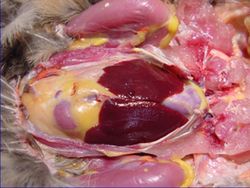Difference between revisions of "Avian Liver - Anatomy & Physiology"
m (Text replace - "Category:To Do - Review" to "Category:To Do - AP Review") |
|||
| Line 35: | Line 35: | ||
[[Category:Avian Alimentary System - Anatomy & Physiology]] | [[Category:Avian Alimentary System - Anatomy & Physiology]] | ||
| − | [[Category:To Do - AimeeHicks]][[Category:To Do - Review]] | + | [[Category:To Do - AimeeHicks]][[Category:To Do - AP Review]] |
Revision as of 12:14, 18 October 2010
Structure
The liver has 2 lobes. It is dark brown coloured (except just after hatching where it is yellow). The right lobe larger than left lobe. It is positioned ventral and caudal to the heart (as there is no diaphragm). It is closely associated to the proventriculus and spleen. It has a thin capsule and indistinct lobation. 2 bile ducts enter the distal duodenum, one from each lobe of the liver. The duct from the right lobe is connected to the gallbladder. Hepatic lobules are indistinct (except near hilus) due to a lack of perilobular connective tissue. Avian bile aids the emulsification of fats and contains amylase and lipase.
Function
See liver function.
Vasculature
See liver vasculature.
Innervation
See liver innervation.
Lymphatics
See liver lymphatics.
Gallbladder- Species Differences
Pigeons and parrots lack a gall bladder.
Links
Test yourself with the Avian Alimentary Tract Flashcards
Click here for Avian liver histology
Click here for more information on Liver - Anatomy & Physiology

